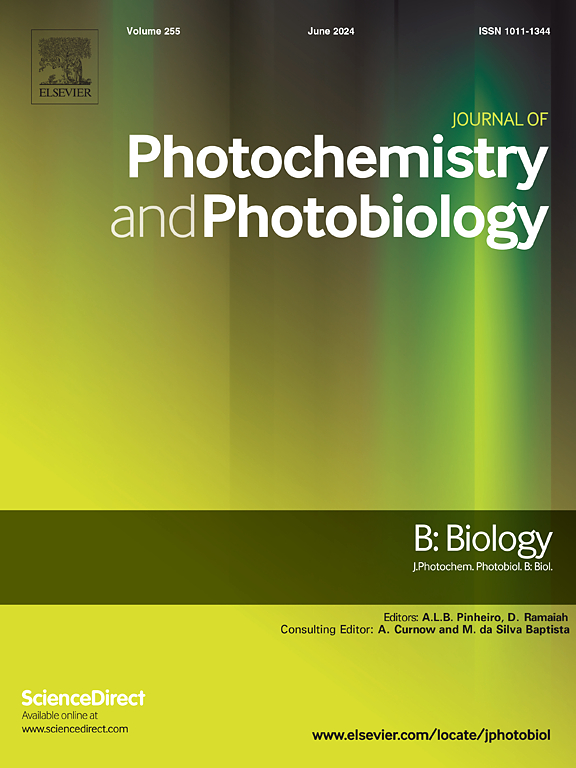纳米银颗粒和矿物质营养成分对茄科植物光合过程、叶绿体超微结构和生产力的长期影响。
IF 3.9
2区 生物学
Q2 BIOCHEMISTRY & MOLECULAR BIOLOGY
Journal of photochemistry and photobiology. B, Biology
Pub Date : 2024-09-27
DOI:10.1016/j.jphotobiol.2024.113038
引用次数: 0
摘要
研究了银纳米粒子(AgNPs)单独或与矿质营养元素结合使用对茄科植物生长和光合作用的影响。实验包括在夏季的温室中每周施用 10 μmol 的 AgNPs,持续 15 周。在实验之前和整个实验过程中,通过 TEM、ESI/EELS 和 zeta 电位测量对 AgNPs 进行了全面鉴定。此外,还测量了 PSII 活性、气孔导度、光合作用、蒸腾和呼吸速率,并评估了光合色素、叶绿体超微结构以及叶片、根和果实的干重和鲜重。结果表明,AgNPs 与矿质营养元素的结合提高了 PSII 活性和光合速率,并改变了叶绿体的超微结构。然而,单独使用矿物养分或 AgNPs 并不会引起这些变化。原子吸收光谱法在除果实以外的所有植物器官中都检测到了 AgNPs。Veni Prisma® 是一种含有胶体银的商业产品,它也会导致果实成熟不同步,因此果实产量最高。本研究推测,AgNPs 和矿质营养素的协同作用可增强叶绿体中银的积累,提高光利用率和光合效率,尤其是在弱光条件下,从而增加果实数量和干重。相反,长期单独使用 AgNPs 会导致银在叶绿体外积累,并不会提高光合作用或增加鲜果质量。本文章由计算机程序翻译,如有差异,请以英文原文为准。
Long-term effects of silver nanoparticles and mineral nutrition components on the photosynthetic processes, chloroplast ultrastructure and productivity of Solanum lycopersicum plants
The effects of silver nanoparticles (AgNPs), both alone and in combination with mineral nutrients, on the growth and photosynthesis of Solanum lycopersicum plants during ontogeny were studied. The experiment involved weekly applications of 10 μmol of AgNPs for 15 weeks in a greenhouse over a summer period. A comprehensive characterization of the AgNPs was performed via TEM, ESI/EELS, and zeta potential measurements before and throughout the experiment. The activity of PSII, stomatal conductivity, photosynthesis, transpiration and respiration rates were measured, and the photosynthetic pigments, chloroplast ultrastructure, and dry and fresh masses of leaves, roots, and fruits were assessed. The results indicated that combining AgNPs with mineral nutrients increased PSII activity and the photosynthesis rate and altered the chloroplast ultrastructure. However, the use of mineral nutrients or AgNPs alone did not induce these changes. Atomic absorption spectrometry detected AgNPs in all the plant organs except the fruits. The highest fruit yield was associated with Veni Prisma®, a commercial product containing colloidal silver, which also caused desynchronized fruit maturation. This study hypothesizes that the synergistic effect of AgNPs and mineral nutrients enhances silver accumulation in chloroplasts, improving light utilization and photosynthetic efficiency, particularly under low light, thus increasing fruit quantity and dry mass. Conversely, long-term use of AgNPs alone was accompanied by silver accumulation outside the chloroplasts and did not lead to increased photosynthesis or an increase in fresh fruit mass.
求助全文
通过发布文献求助,成功后即可免费获取论文全文。
去求助
来源期刊
CiteScore
12.10
自引率
1.90%
发文量
161
审稿时长
37 days
期刊介绍:
The Journal of Photochemistry and Photobiology B: Biology provides a forum for the publication of papers relating to the various aspects of photobiology, as well as a means for communication in this multidisciplinary field.
The scope includes:
- Bioluminescence
- Chronobiology
- DNA repair
- Environmental photobiology
- Nanotechnology in photobiology
- Photocarcinogenesis
- Photochemistry of biomolecules
- Photodynamic therapy
- Photomedicine
- Photomorphogenesis
- Photomovement
- Photoreception
- Photosensitization
- Photosynthesis
- Phototechnology
- Spectroscopy of biological systems
- UV and visible radiation effects and vision.

 求助内容:
求助内容: 应助结果提醒方式:
应助结果提醒方式:


